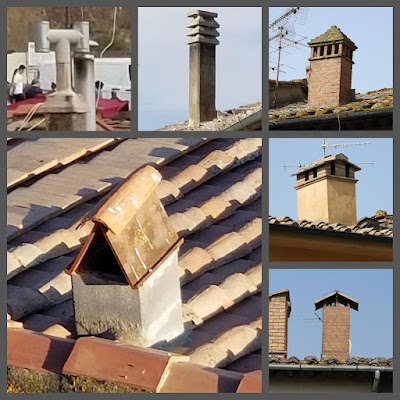Thanks to the guys in Volterra,
currently enjoying the reality capture workshop. There are several of us out
here, wishing we could have joined and appreciating the posts you are sharing.
I was there in 2018 and particularly interested in the
construction details that had evolved in the local vernacular. Chimneys sprout
across the rooftops, some for fireplaces some for woodstoves.
Compared to England there is great concern to protect
the opening from rainfall. Is this just a quirk? Perhaps it reflects the number
of days in the year when fires actually burn. A strong upward draft will
deflect rain as well as any physical barrier, I suspect.
Four windows from Volterra, snapped
in 2018.
The double arch motif is common in Tuscany and often
enough there are rectangular wooden frames "hiding" behind the stone
outer layer.
That tradition goes back to the medieval era and often
enough uses pointed arches. The heavy rusticated surrounds are firmly post
Renaissance though. Shades of the heavy Mannerism of Giulio Romano.
And then there is the simplicity of a running moulding
topped by a pediment. The "temple front" motif which harks back to
the Etruscans and the Greeks.
Can't help thinking we lost something along the way to
modernity, for all its many benefits.
Second pass on the fourth panel this
morning. I guess I am going in reverse order, this time around. Actually I just
chose the one I was least happy with for further development.
Paint brush on canvas is a great way to start my
weekend.
Window shutters snapped in Volterra
in 2018. There is a deceptive commonality to this tradition which masks the
underlying complexity and variation.
Some shutters are side-hung and open out, with a
top-hung portion, nested within each of the two main shutters. This enables
great flexibility in control of light and ventilation depending on the time of
day and season of the year. Privacy and security are also factors of course.
A modern "rethink" has introduced sliding
shutters into the mix. These can be combined with external metal bars in
situation where the side hung style would clash.
But there is also a tradition of inward opening
shutters, often nested within the glazed opening sashes. I am guessing that
these were sometimes installed without glass, when that material was a luxury
item.
In that case the internal shutters would be the only
protection against rain. Hence the blank shutters in place of the louvred type
Ground floor windows in Volterra
often boast a security grille. There are many variations.
One of my favourite details is when the blacksmith
forms a thickening of the vertical bars, allowing an eye to be formed, through
which the horizontals can be threaded.
Looking at this collection now, I think I prefer the simpler
rectangular grids to the more elaborate patterns which tend to detract from the
window itself.
There is an extensive underground
drainage system in Volterra, collecting run-off from the streets and channeling
it to storage cisterns. At the city gates there are public water troughs, still
in evidence.
I'm sure this was critical infrastructure for an
ancient hilltop city. The access points (rodding ways?) Fascinated me when I
first noticed them in 2018. You can also find these in Florence if you keep
your eyes open.
Small circular stone lids, set in stone frames. I would
love to see the traditional method for opening these up.
Was there a filtration system for cleaning the runoff?
Was the water not for human consumption? Maybe they boiled the drinking water?
I always have more questions than answers.






No comments:
Post a Comment
I've been getting a lot of spam so had to tighten up comments permissions. Sorry for any inconvenience. I do like to hear from real people